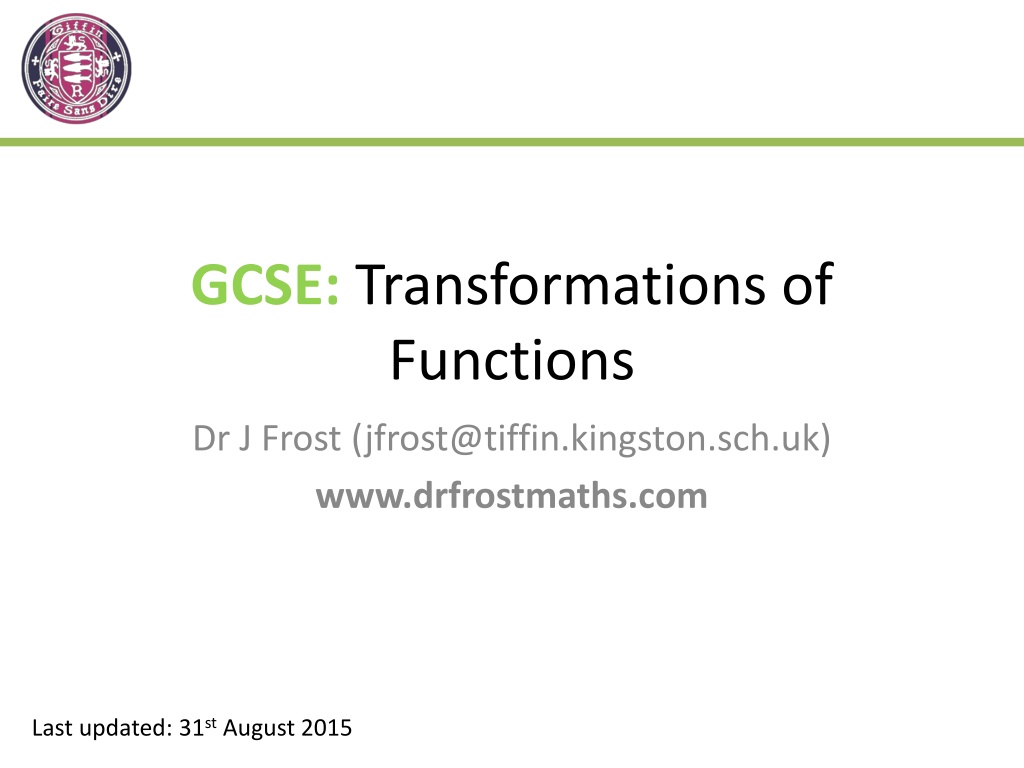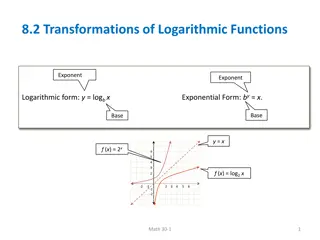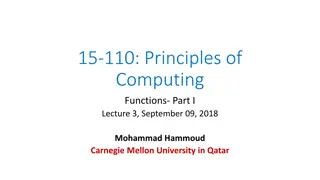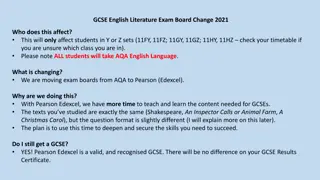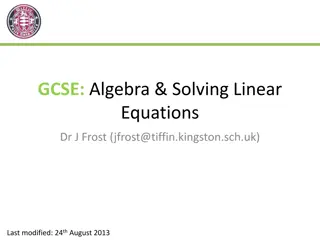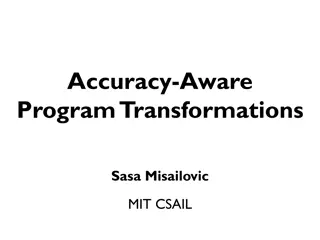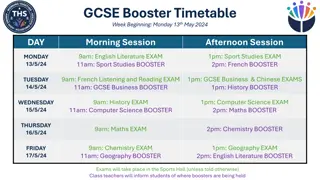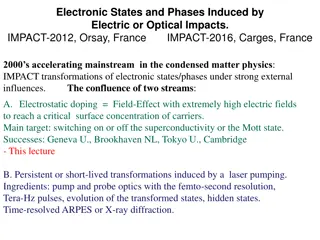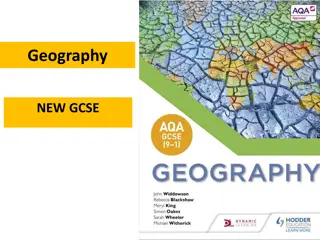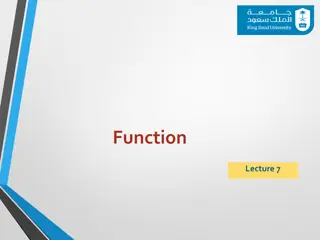GCSE Transformations of Functions
This resource covers fundamental concepts of transformations of functions in GCSE mathematics, including function rules, input-output relationships, and graph transformations. It explores how changing inputs affects outputs and how to apply transformations to functions. Practice problems and visual aids help reinforce understanding.
Uploaded on Feb 24, 2025 | 0 Views
Download Presentation

Please find below an Image/Link to download the presentation.
The content on the website is provided AS IS for your information and personal use only. It may not be sold, licensed, or shared on other websites without obtaining consent from the author.If you encounter any issues during the download, it is possible that the publisher has removed the file from their server.
You are allowed to download the files provided on this website for personal or commercial use, subject to the condition that they are used lawfully. All files are the property of their respective owners.
The content on the website is provided AS IS for your information and personal use only. It may not be sold, licensed, or shared on other websites without obtaining consent from the author.
E N D
Presentation Transcript
GCSE: Transformations of Functions Dr J Frost (jfrost@tiffin.kingston.sch.uk) www.drfrostmaths.com Last updated: 31st August 2015
Recap of functions A function is something which provides a rule on how to map inputs to outputs. Input Output f(x) = 2x Input Output f x 2x
Check Your Understanding ?(?) = ?2+ 2 What does this function do? It squares the input then adds 2 to it. Q1 ? What is f(3)? f(3) = 32 + 2 = 11 Q2 ? What is f(-5)? f(-5) = 27 Q3 ? If f(a) = 38, what is a? a2 + 2 = 38 So a = 6 Q4 ?
Transformations of Functions We saw that whatever is between the f( ) brackets is the input. If we were to replace x with say 3, we saw that we just substitute x with 3 on the RHS to find the output. Given that the function f is defined as f(x) = x2 + 2, determine: = (x + 1)2 + 2 = x2 + 2x + 3 f(x + 1) ? = x2 + 2 + 3 = x2 + 5 f(x) + 3 ? = (2x)2 + 2 = 4x2 + 2 f(2x) ? = 2(x2 + 2) = 2x2 + 4 2f(x) ?
Test Your Understanding Given ? ? = ?2+ 2? 1 Find: ? ? + 1 = ??+ ?? ? ? ? + 1 = ? + ??+ ? ? + ? ? = ??+ ?? + ? + ?? + ? ? = ??+ ?? + ? ? = ???+ ? ?? ? = ???+ ?? ? ? 2? ?
Exercise 3 Given that ? ? =1 ?, find: 3 Given that f(x) = cos(x), find: 1 1 ? ? ? ? ? ? f(2x) f(x + 1) f(x) 3 9f(x) f(0) = cos(2x) = cos(x + 1) = cos(x) 3 = 9cos(x) = 1 ? 2? = 2? 1 ? ? ? ? ? + 1 = ? + 1 =1 ? 3 =9 ? =1 4 ? ? 3 9? ? Given that f(x) = x2, find: 2 ? ? 4 ? = (2x)2 = 4x2 = (x + 1)2 = x2 + 2x + 1 = x2 3 = 9x2 = 16 ? ? f(2x) f(x + 1) f(x) 3 9f(x) f(4) ? 4 Given that ? ? = 2? 1, find: ? ? ? ? ? ? ? 2? ? ? + 1 ? ? 3 9? ? ? 4 Given ? ? = 11, find ? ?? ? = ?? ? = ? ? = 4? 1 = 2? + 1 = 2? 4 = 18? 9 = 7 Given ? ? = 25, find ? ? ? = ?
Transformations of Functions ? Suppose f(x) = x2 Then f(x + 2) = (x + 2)2 Sketch y = f(x): Sketch y = f(x + 2): y y ? ? x x -2 What do you notice about the relationship between the graphs of y = f(x) and y = f(x + 2)?
Transformations of Functions This is all you need to remember when considering how transforming your function transforms your graph... Affects which axis? What we expect or opposite? ? ? ? ? Change inside f( ) x Opposite y Change outside f( ) What we expect Therefore... ? f(x + 2) Shift left by 2 units. f(x) + 4 Shift up by 4 units. ? f(5x) Squash on x-axis by factor of 5 ? 2f(x) Stretch on y-axis by factor of 2 ?
Effect of transformation on specific points What effect will the following transformations have on these points? ? ? ?,? ? ? ? ? ? ? ? ?,? ? ? ? ? ? ? ? ?, ? ? ? ? ? ? ? ? ? ? + 1 3,3 0,0 5, 4 ? 2? 2,3 0.5,0 3, 4 3? ? 4,9 1,0 6, 12 ? ? 1 4,2 1, 1 6, 5 ? 4 12,3 4,0 24, 4 ? ? ? 4,3 1,0 6, 4 ? ? 4, 3 1,0 6,4
Exam Example Shifts right 2 so: (5, -4) ? Shift left 5 and up 6: (-2, 2) ?
Exercise B Describe the affects of the following graph transformations. The point (0, 0) on a curve y = f(x) is mapped to the following points. Find the equation for the translated curve. ? ????? 3 1 ????? ? ?? ? = ?(? + 10)Left 10 units. ? = 3?(?)Stretch by factor of 3 on y-axis. ? = ?(2?)Squash by factor of 2 on x-axis. ? = ? ? 4Move down 4 units. ? = ? 2Stretched by factor of 2 on x-axis. ? = ? 3? + 4Squashed by a factor of 3 on x-axis, and move up 4 units. ? = ? ?Reflected on y-axis. ? = ?(?)Reflected on x-axis. ? = ?(? ?) ? = ? ? + ? ? = ?(? + ?) ? = ? ? ? ? = ? ? ? ? ? = ? ? + ? + ? (4, 0) (0, 3) (-5, 0) (0, -1) (5, -3) (-5, 2) ? To what points will (-2, 0) on the curve y = f(x) be transformed to under the following transformations? 4 To what point will (4, -1) on the curve y = f(x) be transformed to under the following transformations? 2 (-1, 0) (-2, 0) ?????? ? = ?(2?) ? = 2?(?) ? = ? ? = ? ? 1 1 ? = ? ? + 1 ? = ? ? + 1 ? 3+ 1 ?????? (-6, 1) (-1, -1) (2, 1) (-2, 0) ? = ?(2?) ? = 5?(?) ? = 2? 4? ? = ? ? + 1 + 1 ? = ? ? ? = ?(?) (2, -1) (4, -5) (1, -2) (3, 0) (-4, -1) (4, 1) 5 Find the equation of the curve obtained when ? = ??+ ?? is: ??? Translated 5 units up. ? = ??+ ?? + ? Translated 2 units right. ? = ? ??+ ? ? ? Reflected in x-axis. ? = ?? ?? a) b) c)
Drawing Transformed Graphs The graph shows the line with equation ? = ?(?). On the same axis, sketch ? = ? 2? ? = ?(2?) has the effect of: Halving ?? The mark scheme will check you have certain key points correct, so the key is to identify points exactly on the grid and transform one at a time. This point is exactly on the grid lines. Where does it end up?
Quickfire Transforms On provided sheet-ette
Quickfire Transforms On provided sheet-ette
f(-x) and f(x) Below is a sketch of y= f(x) where f(x) = (x 2)2. Hence sketch the following. y y 4 4 x x -2 2 2 Since the is outside the brackets, the y values get multiplied by -1. -4 Since the is inside the brackets, the x values get multiplied by -1. Click to Brosketch y = f(-x) Click to Brosketch y = -f(x)
Describing Transforms The blue graph shows the line with equation ? = ?(?). What is the equation of graph G, in terms of ?? The graph has moved 5 units to the left, so: ? = ?(? + ?) ?
Quickfire Describing Transforms Given the blue graph has equation ? = ?(?), determine the equation of the red graph. ? ? = ?(? 2) ? ? = ? ? + 2 ? 1 2? + 1 ? ? = ?(2?) ? = ?
GCSE: Transformations of Trig Functions Dr J Frost (jfrost@tiffin.kingston.sch.uk)
Example Bro Tip: The function here is the sin. So consider whether the change happens inside or outside the sin. Below is a sketch of y = sin(x). Hence sketch the following. y y 2 2 1 1 x x -360 -270 -180 -90 90 180 270 360 -360 -270 -180 -90 90 180 270 360 -1 -1 -2 -2 Click to Brosketch y = sin(x + 90) Click to Brosketch y = 2sin(x)
Example Below is a sketch of y = sin(x). Hence sketch the following. y y 2 2 1 1 x x -360 -270 -180 -90 90 180 270 360 -360 -270 -180 -90 90 180 270 360 -1 -1 -2 -2 Click to Brosketch y = sin(2x) Click to Brosketch y = 1.5sin(x/2)
Exercises On printed sheets. (File ref: GCSERevision-TrigGraphs)
Describing Transforms of Trig Graphs The graph shows the line with equation ? = sin ?? + ?. Determine the constants ? and ?. ? = 2 Helpful questions to ask yourself: Usually the sine graph makes one full oscillation every 360. How many oscillations per 360 is it making here? sin usually has a range on the y-axis of -1 to 1. What is it here? ? As the graph oscillates twice as much (as ? values are halved) ? = 1 ? As range of -1 to 1 has increased to 0 to 2.
Describing Transforms of Trig Graphs The graph shows the line with equation ? = ? sin ?? + ?. Determine the constants ?,? and ?. ? ? ? ? = 2 ? = 4 ? = 1
